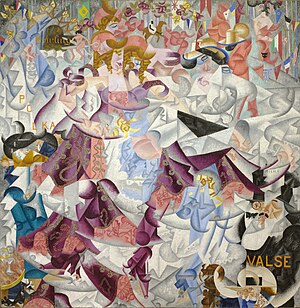
Back Futurisme Afrikaans Futurismus ALS مستقبلية Arabic المستقبليه ARZ Futurismu AST Futurizm Azerbaijani Футурызм Byelorussian Футурызм BE-X-OLD Футуризъм Bulgarian Futurizam BS


Futurism (Italian: Futurismo [futuˈrizmo]) was an artistic and social movement that originated in Italy, and to a lesser extent in other countries, in the early 20th century. It emphasized dynamism, speed, technology, youth, violence, and objects such as the car, the airplane, and the industrial city. Its key figures included Italian artists Filippo Tommaso Marinetti, Umberto Boccioni, Carlo Carrà, Fortunato Depero, Gino Severini, Giacomo Balla, and Luigi Russolo. Italian Futurism glorified modernity and, according to its doctrine, "aimed to liberate Italy from the weight of its past."[1] Important Futurist works included Marinetti's 1909 Manifesto of Futurism, Boccioni's 1913 sculpture Unique Forms of Continuity in Space, Balla's 1913–1914 painting Abstract Speed + Sound, and Russolo's The Art of Noises (1913).
Although Futurism was largely an Italian phenomenon, parallel movements emerged in Russia, where some Russian Futurists would later go on to found groups of their own; other countries either had a few Futurists or had movements inspired by Futurism. The Futurists practiced in every medium of art, including painting, sculpture, ceramics, graphic design, industrial design, interior design, urban design, theatre, film, fashion, textiles, literature, music, architecture, and cooking.
To some extent, Futurism influenced the art movements Art Deco, Constructivism, Surrealism, and Dada; to a greater degree, Precisionism, Rayonism, and Vorticism. Passéism can represent an opposing trend or attitude.[2]
- ^ The 20th-Century art book (Reprinted. ed.). dsdLondon: Phaidon Press. 2001. p. 506. ISBN 978-0714835426.
- ^
Shershenevich, V. (2005) [1988]. "From Green Street". In Lawton, Anna; Eagle, Herbert (eds.). Words in Revolution: Russian Futurist Manifestoes, 1912–1928. Translated by Lawton, Anna; Eagle, Herbert. Washington, DC: New Academia Publishing, LLC. p. 153. ISBN 9780974493473. Retrieved 18 January 2022.
Italo-Futurism flees the shores of passéism because the tentacles of passéism are suffocating it; it is flight from captivity. Russian Futurism flees passéism like a man who steps back in preparing to leap forward.